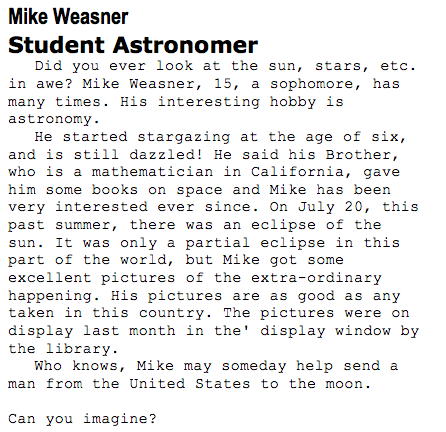
Venus-Moon Conjunction, Earthshine, NGC7048
Posted: 27 December 2011
I opened the observatory Monday, 26 December, at 1808 MST, 50°F. I then stepped back outside of the observatory and took this photo of the observatory, with the Venus-Moon conjuction, using an iPhone 4:

I used the D7000 DSLR, f/4.8, 1/5sec, 125mm, ISO 500, to capture this view of the conjunction and Earthshine on the crescent moon:

I then powered up the 8" LX200-ACF at 1819 MST, and took a quick look at Venus, 77X. Then over to the moon. Earthshine was lovely at 77X. I began setting up for lunar prime focus imaging with the D7000 DSLR. This image was 1/320sec, ISO 800:

I added the focal reducer and captured this image, 1/2sec, ISO 800, showing the Earthshine:

Some stars are even visible in the image. By the way, the iPhone photo and the Earthshine image above were processed through the noise reduction software I am testing. My review will be posted online later today.
I removed the camera and viewed the moon with the 26mm eyepiece + focal reducer. This wide angle view provided a nice look at the Earthshine. Stars were easily seen and I noticed that some would be occulted by the Earth-lit side within a few minutes. I removed the focal reducer and switched to the 9.7mm (206X) eyepiece to observe an occultation, which occurred about 1854 MST. I then did a lunar terminator tour. The moon was too low by this time for good viewing.
At 1900 MST, I began my attempt to observe NGC7048, a small (1 arc minute), faint (Magnitude +12.1), planetary nebula in the constellation of Cygnus. I SYNCed the AutoStar on the star Deneb and used the 15mm (133X) eyepiece to try for the nebula. I could just see some faint nebulosity using averted vision. I then set up for prime focus imaging of NGC7048. I did a focus test on Deneb using the Bahtinov Mask. I then did 30, 60, 90, and 120 second, ISO 6400, exposures. Unfortunately, exposures longer than 60 seconds trailed this night. I decided I would add the Off-Axis Guider and do some long guided exposures, but that would have to wait until the next night, as Cygnus would be too low in the sky by the time I would be ready to image. But this 60 second exposure (full-frame) shows NGC7048:

This image was also processed through the noise reduction software.
I ended DSO imaging at 1940 MST and viewed Jupiter at 77X and 206X. Four moons were visible. I then set up for some eyepiece projection test imaging using a 9mm (222X) eyepiece at the OPT Camera Adapter. I did several test exposures and a test video. Unfortunately, the exposures were too short and the resulting images were too underexposed to be useful. Will try again on a future session.
At 2024 MST, viewed M42, the Great Orion Nebula, at 77X. I then SYNCed the AutoStar on the star Betelgeuse and slewed to NGC2029, the Flame Nebula. Viewed the nebula at 77X and 133X. By placing the bright star Alnitak (leftmost star in Orion's belt) out of the field-of-view, the Flame Nebula was nicely visible. It was best viewed at 77X.
At 2032 MST, viewed M1, the Crab Nebula. Always a nice object.
Closed the observatory at 2050 MST, 47°F.
On my 25 December 2011 report, I mentioned needing to switch to a different iOS app for long exposure timing. Sven-Ove Auno wrote to me asking if I have tried "SkyTime". I do have SkyTime on my iPhone. But the time display is small and it doesn't support landscape mode. (I had made a holder (http://web.mac.com/jhearne/iWeb/Site/Easel.html) for the iPhone in landscape mode.) The clock apps I've tried do support landscape and have larger numerals. SkyTime is still a good app that displays useful information for the astronomer.
A relative sent me a scanned copy of the October 1963 edition of my high school newspaper. I was mentioned:

Wow, memories!
Go to the previous report.
Return to the Cassiopeia Observatory Welcome Page.